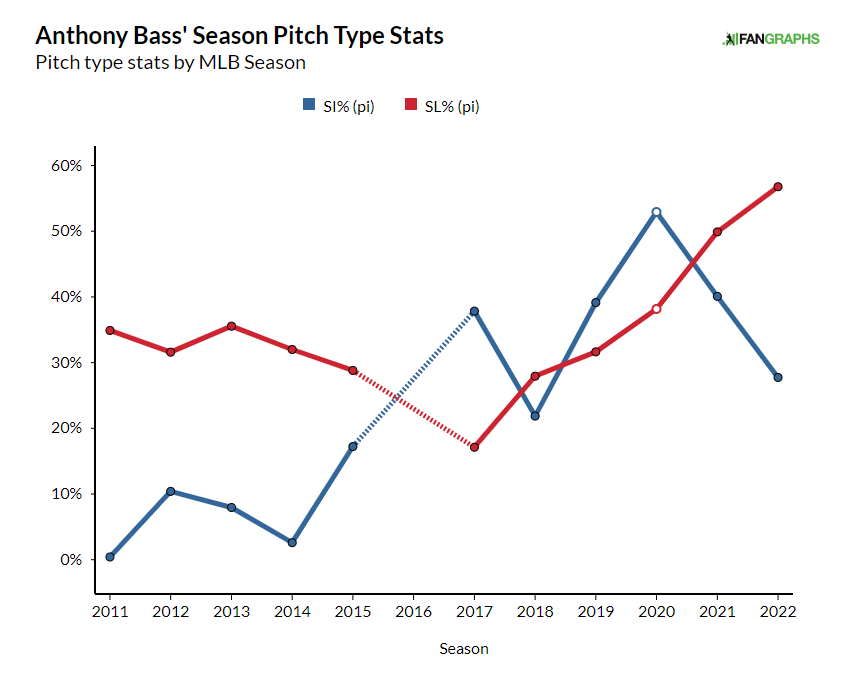Blue Jays Jazz Up Bullpen With Pop and Bass

Currently holding the top spot in the AL Wild Card race and a 12–3 record over the last three weeks, it seems like the Blue Jays are finally playing up to this season’s lofty expectations. But despite their recent hot streak, there were spots on the roster that needed to be addressed in order to bolster their playoff odds — notably their pitching depth. They focused on doing just that at the trade deadline by acquiring relievers Anthony Bass and Zach Pop and a player to be named later in exchange for shortstop prospect Jordan Groshans.
This is Bass’ second stint with the Blue Jays; he spent the shortened 2020 season in Toronto, compiling 0.4 WAR with a 3.51 ERA in 26 appearances that year. He signed a two-year deal with the Marlins in 2021 but struggled in his first season in Miami, with his FIP increasing by more than a run, even though his ERA only saw a slight increase. A 62.3% groundball rate in Toronto dropped to 43.7% with the Marlins, and all that additional contact in the air led to a huge increase in balls flying over the fence.
Surprisingly, despite his groundball rate falling even further this year to a career-low 39.0%, Bass is in the midst of a career-best season. His strikeout rate has increased to 26.0%, a career high, and his walk rate has fallen by more than three points. More encouragingly, he’s only allowed a single home run this year. The result is a 1.41 ERA, a 2.06 FIP, and 1.4 WAR in 45 appearances.
The key to Bass’ turnaround was a significant change to his pitch mix:

Ever since returning from a stint in Japan back in 2016, he’s increased the usage of his slider year over year and is now throwing his breaking ball 56.8% of the time. That’s with good reason, as it’s easily the best pitch in his repertoire, returning a 41.0% whiff rate and a .338 expected wOBA on contact since 2017. All those additional sliders have helped improve the results he’s getting on his sinker, too. That pitch was responsible for most of the issues he struggled with last year, when batters posted a .362 wOBA and .414 xWOBAcon against it. This season, those marks are down to .222 and .349, respectively.
The physical characteristics of the sinker aren’t significantly different; instead, its improvement is related to its usage. Bass is throwing his sinker in the zone more often, helping him lower his walk rate. Batters are swinging at the pitch more often, too, though the biggest increase in swings has come on sinkers located outside of the zone. Previously, he was getting batters to chase the pitch around 12% of the time; that rate has shot up to 26.6% in 2022. By throwing so many more sliders, he’s made it much more difficult for batters to track and hit his sinker.
Like Bass, Pop’s repertoire begins and ends with a sinker and a slider. A Rule 5 pick last year, he’s spent this season in the Marlins’ bullpen, posting a 4.12 ERA and a 3.77 FIP in 50 appearances. He’s leaned into his sinker this year, increasing his usage of the pitch up to 83.2%. That’s helped him increase his groundball rate up to 63.1%, and while it’s come at the cost of some whiffs — his 16.9% strikeout rate is pedestrian at best — he’s also cut his walk rate all the way down to 2.4% by pounding the zone with sinkers. The result is an elite 7.0 strikeout-to-walk ratio combined with that stellar groundball rate. He’s also just 25 years old and comes with five more years of team control.
Both relievers should bolster a Blue Jays bullpen that has been a clear area of weakness for the team this year. As a group, they’ve posted a 106 FIP-, the sixth-worst mark in the majors, and 60 meltdowns, eighth-most in the league. Their collective ERA is nearly a third of a run better than their FIP, but there simply weren’t that many trustworthy options to bridge the gap to Jordan Romano in the ninth inning. Bass should likely slot into a seventh- or eighth-inning role, and Pop should be a useful option in the middle innings.
In return, the Marlins get Groshans, who was the Blue Jays’ No. 6 prospect, per our updated 2022 rankings. A former first-round pick, he was in the middle of a breakout campaign in ’19 before a severe foot injury cut his season short, then lost another year of development in ’20 due to the pandemic wiping out the minor league campaign. Assigned to Double-A as a 21-year-old last year, he posted a .291/.367/.450 slash line (124 wRC+) and looked like a future contributor, but his first exposure to Triple-A this year has been a mess, with a .250/.348/.296 slash line (82 wRC+) in 279 plate appearances and the second-lowest slugging percentage among all qualified batters at his level.
The disappearance of Groshans’ in-game power confirms some of the questions in his prospect profile, as he’s never posted good exit velocities in the minors. Thankfully, his excellent plate approach and good bat-to-ball skills have buoyed him somewhat. Further complicating things is that, while he’s continued to man shortstop regularly in Buffalo, he projects to move to third base by the time he’s ready for the majors, giving him an unconventional profile for a corner infield position. For now, he’ll join a strong Marlins system that has plenty of intriguing middle infielders, the majority of whom are down in the lower levels of the minors.
Jake Mailhot is a contributor to FanGraphs. A long-suffering Mariners fan, he also writes about them for Lookout Landing. Follow him on BlueSky @jakemailhot.

You really rocked that headline.